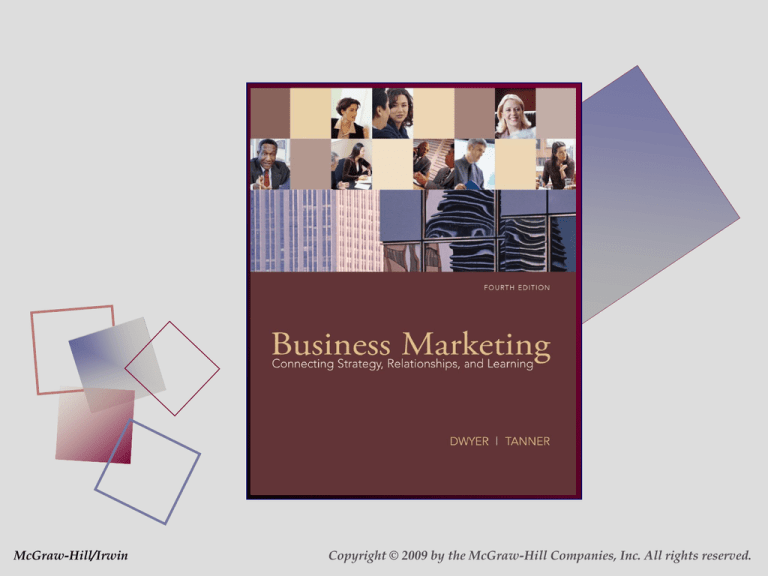
McGraw-Hill/Irwin
Copyright © 2009 by the McGraw-Hill Companies, Inc. All rights reserved.
Chapter 16
Customer Retention
and Maximization
THE NATURE OF A CUSTOMER
Customer Relationships can be found at any level
Always-A-Share
Customer
Highest Level
Relationship
THE KEY FACTOR:
SWITCHING COSTS
The Direct and
Indirect costs a
buyer will have
to pay to go to
another supplier
Lost-For-Good
Customers
Lowest Level
Relationship
16-3
DEFINING THE EXTREMES OF CUSTOMER NATURE
ALWAYS-A-SHARE
LOST-FOR-GOOD
Customers are tied to a
system. Switching
costs may include:
• Specific investments
• Cancellation penalties
• Setup costs for a new
supplier
•Retraining
•Finding/Evaluating a
new supplier
Customers can allocate
their purchases to
several vendors . A
period of no purchases
can be followed by a
number of purchases.
Doesn’t want to rely on
a single vendor.
Suppliers are largely
interchangeable
Exhibit 16-1
16-4
PAYOFFS TO SELLERS FROM
LONG TERM CUSTOMER RELATIONSHIPS
•
•
•
•
GROWS ADDITIONAL BUSINESS OPPORTUNITIES
for new products or increased purchases
PREMIUM PRICES result from giving first-rate service
and product quality
REDUCED SELLING COSTS from tighter coordination
of production and logistics
ADDITIONAL REVENUES POSSIBLE from customers’
referrals and joint sales calls with customers
16-5
RELATIONSHIP BENEFITS TO SELLERS
500
Referrals
300
Reduced
costs
200
Price
Premium
100
Increased
Purchases
Profits
400
0
Base profit
1
2
3
4
5
6
Years in Relationship
Exhibit 16-5
16-6
TWO REASONS COMPANIES STAY
IN A BUSINESS RELATIONSHIP
REASON 1.
THEY HAVE TO
No alternatives, binding actions
such as contracts, product ties
REASON 2.
THEY WANT TO
Relationship is satisfying
because of cooperation and
meeting financial objectives
16-7
TIES THAT BUILD RELATIONSHIPS
•
•
•
•
SUPERIOR PERFORMANCE at a good price (value)
SOCIAL RELATIONSHIPS created by frequent
interaction
TECHNICAL DEPENDENCIES brought about by
reliance on a supplier’s products or support
FORMAL AGREEMENTS involving investments or
contracts
16-8
SOURCES OF
COMPETITIVE ADVANTAGE
TO BUILD CUSTOMER LOYALTY, DEVELOP A
COMPETITIVE ADVANTAGE BY PROVIDING
1. Superior performance
2. Quality products and support as defined by the
customer
3. Distinctive and reliable service
16-9
THE IMPACT OF TRUST AND COMMITMENT ON BUSINESS RELATIONSHIPS
Relationship
Termination
Costs
Relationship
Benefits
Acquiescence
+
+
+
Relationship
Commitment
Propensity
To leave
-
+
+
Shared Values
+
+
Cooperation
+
Trust
+
+
Communication
-
Functional
Conflict
-
Opportunistic
Behavior
Uncertainty
Exhibit 16-8
16-10
COMMUNICATING WITH CUSTOMERS
Telephone
Confirm appointment
Answer a questionnaire about delivery
Fax
Summarize yesterday’s meeting
FYI: an article in a trade magazine
E-mail
Request the name of a former consultant
Give congratulations on a story in the press
Request easy-to-find data in a planning document
Business Letter Formally introduce a new account representative
Summarize reasons for next quarter’s price increase
Thank you for the order
Face-to-face
Negotiate production commitments
Resolve dispute about marketing effort
Exhibit 16-9
16-11
A TOOL FOR CUSTOMER RETENTION:
CUSTOMER SATISFACTION SURVEYS
REQUIREMENTS FOR A USEFUL SURVEY:
1.
2.
CHOOSE MAIL OR TELEPHONE TO DO THE
SURVEY
DETERMINE THE KIND OF INFORMATION
YOU NEED
• Ascertain satisfaction with overall relationship
• Measure specific aspects of the relationship
• The unspoken concerns of customers
• Determine what will get measured regarding
customer expectations (The TERRA model
works well)
• Having meaningful and measurable ratings
and scores
16-12
4-QUESTION SATISFACTION SURVEY
1
2
General overall
Satisfaction question
(Parts reps)
Process 3
(Service manuals)
(Technical Support)
Process 5
(etc.)
Attribute 1
Attribute 1
Attribute 1
Attribute 1
Attribute 1
Attribute 2
Attribute 2
Attribute 2
Attribute 2
Attribute 2
Attribute 3
Attribute 3
Attribute 3
Attribute 3
Attribute 3
Suggest
Suggest
Suggest
Suggest
Suggest
change for
improvement
change for
improvement
change for
improvement
change for
improvement
change for
improvement
Process 1
Process 2
(Parts handling)
3
4
Process 4
Loyalty questions
• Willingness to recommend
• Repurchase intentions
Exhibit 16-10
16-13
MEASURING SATISFACTION
AFTER THE SURVEYS
MANAGEMENT QUESTIONS
1. WHAT DO THE SURVEYS TELL US?
2. HOW DO WE USE THE INFORMATION WE
HAVE?
3. HOW RELIABLE IS THE INFORMATION?
16-14
SATISFACTION SURVEYS:
GUIDELINES FOR USE
1.
LOOK AT OVERALL SCORES
2.
COMPARE SCORES TO PREVIOUS MEASURES,
PREFERABLY OVER SEVERAL YEARS
3.
ARE TRENDS UP, DOWN, STABLE?
4.
HOW MANY FACETS OF SATISFACTION DO WE
MEASURE?
5.
HOW MANY ATTRIBUTES FOR EACH FACET
SHOULD WE MEASURE
6.
WHAT IS OUR RELATIONSHIP FACET
PERFORMANCE SCORE (RFPscore )?
16-15
DETERMINING THE RFP SCORE
OVERALL SATISFACTION = f
sales reps. report cards, warranty claims, product
lit., tech support, etc.
3.2 + .82 (RFPwarranty)
OVERALL SATISFACTION =
+ .53 (RFPrep) + .06 (RFPlit )
+ .12 (RFPtech support) + e
THE REGRESSION COEFFICIENTS SHOW RELATIVE IMPORTANCE
OF EACH FACET. 0.82 FOR WARRANTY CLAIMS IS MOST
IMPORTANT FOR OVERALL SATISFACTION, FOLLOWED BY SALES
REP PERFORMANCE
16-16
STRONG STATISTICAL MODEL
OF CUSTOMER SATISFACTION
Satisfaction
Score
Exhibit 16-12
Warranty
Service RFP
Score
16-17
WEAK STATISTICAL MODEL
OF CUSTOMER SATISFACTION
Satisfaction
Score
Exhibit 16-13
Technical
Support RFP
Score
16-18





